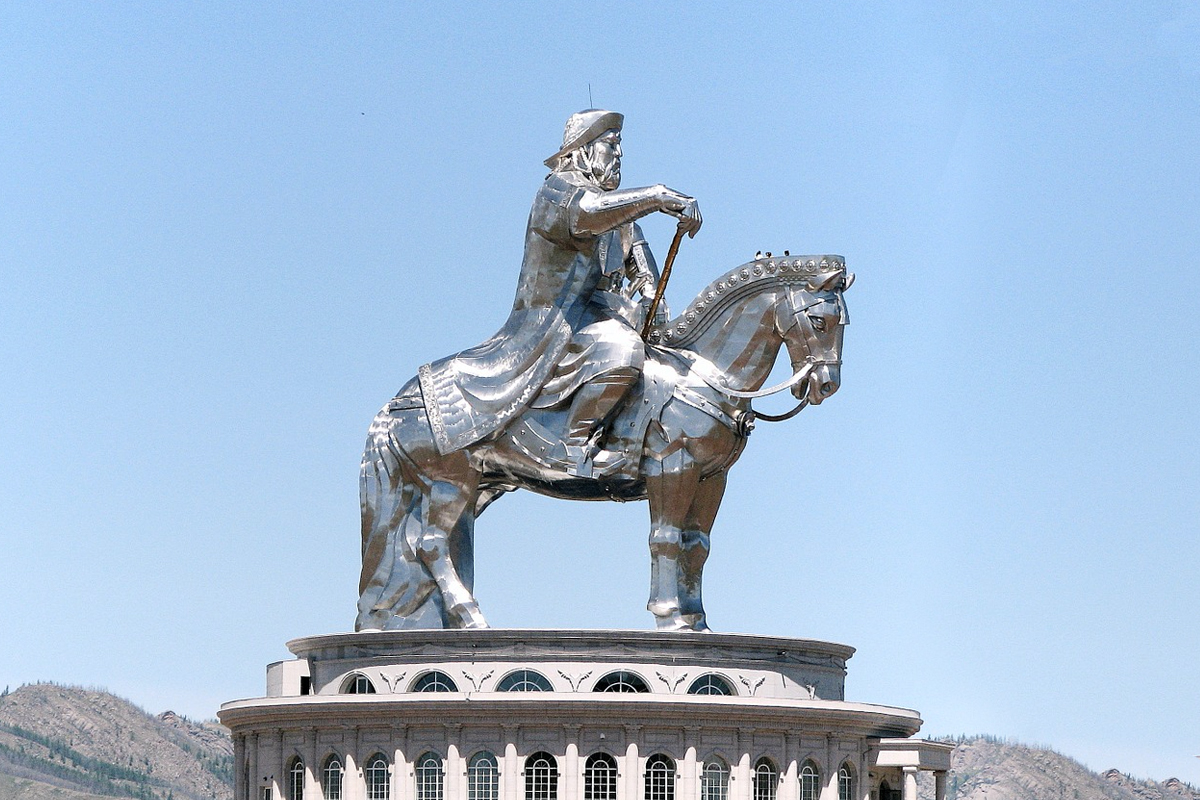The gargantuan stainless steel memorial to the legendary Mongolian leader Genghis Khan
Somewhere on the Mongolian grasslands in the year 1171, a nine-year boy named Temujin, along with his mother, Hoelun, his three brothers and his two half-siblings were left to fend for themselves.
The boy’s father had been the Great Chief and ruler of most of Mongolia, Yesugei Baghatur. He died at the age of 37 after he was fed a poisoned meal by Tatars at a wedding celebration. The Tatars were exacting revenge for an earlier raid on their lands by Yesugei.
The manner of Yesugei’s death in such unpleasant circumstances was ironic. His name translates as ‘like nine’ and in Mongolia, the number nine has always been considered to be the luckiest number. It is a symbol of the power of an intelligent and alert mind.
A ruthless Mongol Emperor
Temujin, which in Mongolian translates to ‘of iron’, survived the time in the wilderness with his remaining family and grew into one of the most admired and feared military leaders in history: Genghis Khan. ‘Khan’ simply means chief or military leader in Mongolian.

A 14th-century portrait of Genghis Khan. At the height of his power the Mongol leader ruled about 17% of the world’s landmass from East Asia to the eastern fringes of Europe.
Genghis Khan and his armies are thought to have been responsible for approximately 40 million deaths which was almost 11% of the entire world’s population at that time. Slaughter on this colossal scale did not return until World War 2; a conflict that killed 70-85 million people, equivalent to 3% of the world’s population.
Demise and revival of a national hero
During the occupation of Mongolia by Soviet forces during the 20th century, Genghis Khan and his legacy began to be removed from Mongolian history. The deeds of the great Mongol leader, both good and bad, were erased from Mongolian school textbooks and he started to fade away.
Once the Soviets left in the early 1990s, Genghis Khan again became a popular figure in Mongolia. His image appears on the country’s banknotes, many of its postal stamps and the main airport in the capital city of Ulaanbaatar also bears his name.

Genghis Khan on the Mongolian 1,000 tugrik banknote. The former Emperor is also celebrated across the country in names of buildings, on stamps and numerous monuments.
Statue memorial to Genghis Khan
Such is the old Khan’s current popularity that the Mongolians have recently erected an enormous statue in his honour. In 2008, a design team led by the Mongolian artist and sculptor D. Erdembileg and the architect J. Enkhajargal completed a complex, built to commemorate Genghis and celebrate his achievements. The centrepiece to this complex is an incredible 250- ton, polished stainless steel statue, portraying Genghis Khan saddled on his horse. The Khan and his steed are gazing sternly towards his place of birth in the East and, in his right hand, the Emperor holds his golden whip. The whip is said to have helped him conquer half the world and has been formed from rose gold PVD stainless steel, very similar to the product made by Double Stone Steel.
The complex is 54 kilometres from Ulaanbaatar on the bank of the river Tuul, the place where the legends say Genghis found his golden whip. The circular base of the statue is a cultural museum where visitors can see a replica of the whip, eat traditional Mongolian food or take an escalator to the viewing platform on top of the horse’s head. The architectural design is intriguing – each of the 36 supporting columns represents a former Khan.

The Genghis Khan memorial complex in Mongolia. The 250-ton, 40m high, stainless steel monument stands on top of a museum and is the largest, equestrian statue in the world.
This monumental statue is the largest equestrian statue in the world, towering 40m above the ground and completely dominating the bleak, grass-filled landscape. We need to think of it as the cultural equivalent of the more famous, ‘Christ the Redeemer’ in Brazil or Mount Rushmore in the USA.






